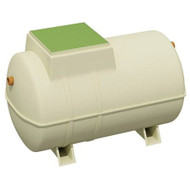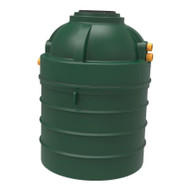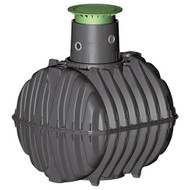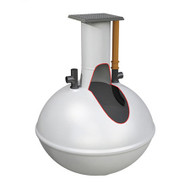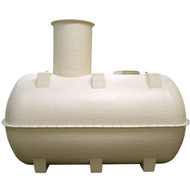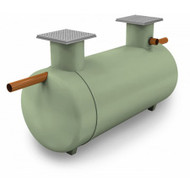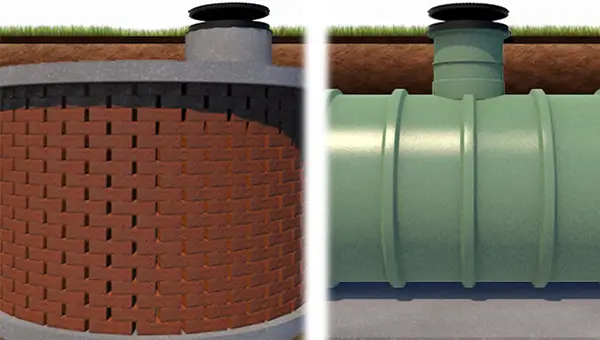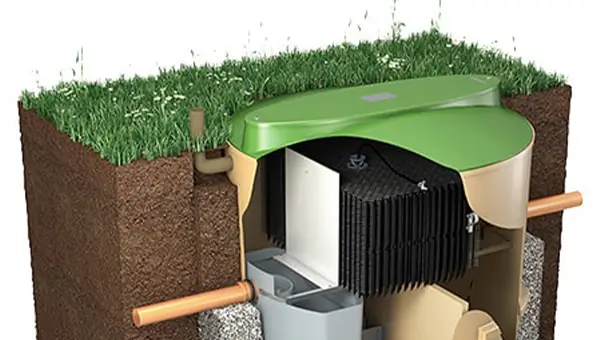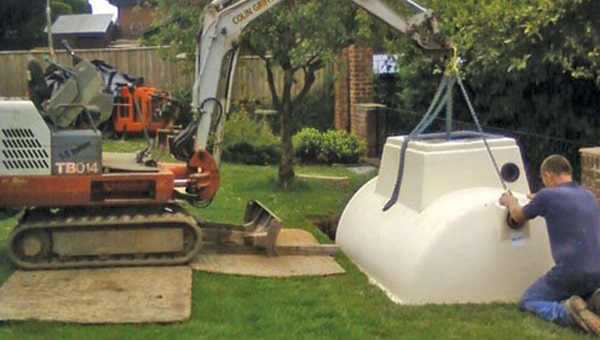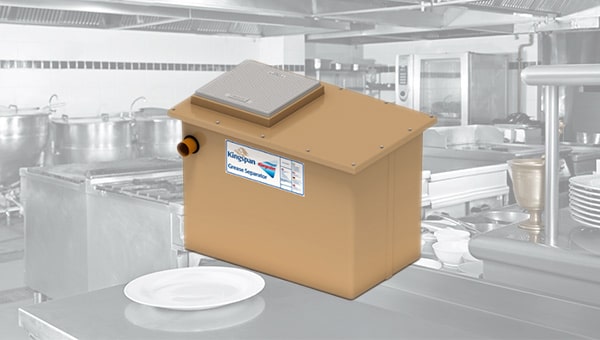Choosing the right size tank is equally as important as choosing the right system. In order to ensure the system works as it is designed to, your tank must be capable of handling the amount of effluent your property produces. But how do you calculate that requirement?
First, make sure you know whether you need a septic tank or sewage treatment plant; each have their pros and cons and restrictions for where they can be used.
Sizing a Sewage Treatment Plant
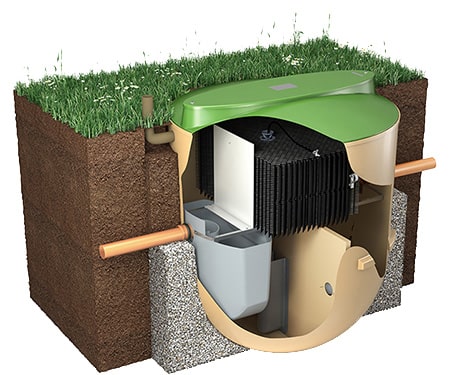
Sewage treatment plants are usually categorised by population size — how many people it caters for — rather than the storage volume of the tank. This makes sizing a sewage treatment plant a single calculation; you need to calculate the Minimum Population (P) figure.
What is Minimum Population (P)?
Confusingly, this doesn't mean the minimum number of people that will live at the property serviced by a sewage treatment plant, but rather the minimum population based on the number of bedrooms it has. According to the Flows and Loads code of practice from British Water, the following figures are used:
For a single house with up to, and including, three bedrooms, a Minimum Population (P) of 5 people should be calculated. For each additional bedroom in a property thereafter, you should calculate for 1 additional person.
Here's some examples:
- A house with three bedrooms = a minimum 5 person system
- A house with four bedrooms = a minimum 6 person system (5 + 1)
- A house with five bedrooms = a minimum 7 person system (5 + 2)
- A house with six bedrooms = a minimum 8 person system (5 + 3)
For groups of small houses or flats the following is recommended:
- One bedroom = a minimum 3 person system
- Two bedrooms = a minimum 4 person system
Where a system is serving a group of houses/flats, you must calculate each one individually and then add the Minimum Population (P) values together.
Example: 4x one bedroom flats are serviced by one sewage treatment plant, you should calculate four lots of 3 people — 3 (people per flat) x 4 (flats in the system) = 12 Minimum Population (P).
A reduction of Minimum Population (P) for 12+ People
If the total population for a group of houses exceeds 12 people then a reduction calculation may be required. This is to allow for the balancing effects on the daily flow of a group of houses.
Where P value total is 13-25 — multiply total P value by 0.9 and round up to provide adjusted P value.
4x three bedroom houses would initially be calculated as 20 P - 5 (people per house) x 4 (houses in the system). This figure would then be multiplied by 0.9 to get the adjusted value of 18 P (20 x 0.9).
Where P value total is 26-50 — multiply total P value by 0.8 and round up to provide adjusted P value.
4x 3 bedroom houses and 3x 4 bedroom houses would give a total of 38 P (4 x 5 & 3 x 6). This figure would then be multiplied by 0.8 to get the adjusted value of 30.4 P (38 x 0.8). As the P value should always be rounded up, this figure then becomes 31 P.
For more information regarding group systems, check out the British Water website for the full code of practice or contact JDP.
Sewage Treatment Plants
Sizing a Septic Tank
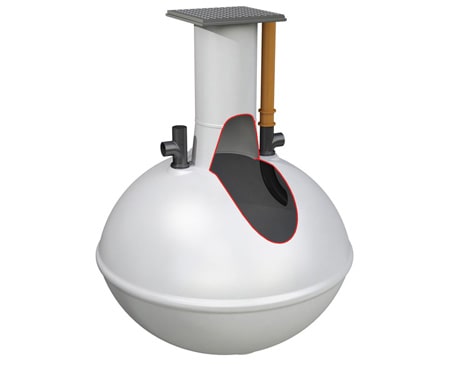
When it comes to septic tanks the calculations become a little bit trickier, as they are usually categorised first by their capacity and than population. You need to know the volume of sewage and wastewater your property is likely to produce in order to work out the capacity you will need.
- Determine the Minimum Population (P) using the same calculations as for sewage treatment plants; examples:
- A house with three bedrooms = a minimum 5 person system
- A house with four bedrooms = a minimum 6 person system (5 + 1)
- A house with five bedrooms = a minimum 7 person system (5 + 2)
- A house with six bedrooms = a minimum 8 person system (5 + 3)
-
Once you have the calculated the Minimum Population (P) for your property, you next need to estimate the number of litres of wastewater produced per day. For standard residential domestic dwellings British Water estimates that one person creates 150L of wastewater per day (for other property types check the full code of practice).
Multiply your Minimum Population (P) by 150 to get your daily estimated wastewater production. For example, a three bed house with a Minimum Population (P) of 5 people would have a daily estimated wastewater production of 750 litres per day (5 x 150).
-
To comply with Building Regulations and the Environment Agency’s General Binding Rules, you must add 2,000L to your daily estimated wastewater production figure in order to arrive at your minimum requirement. This extra capacity is added to allow for the estimated time it takes wastewater to pass through the system; check with your environment authority as other regulations may apply: Scotland (SEPA), Wales (NRW) & Northern Ireland (DAERA).
To continue our three bed house example, the final calculation would be: 750L + 2,000L = 2,750L. The septic tank for this property should have a minimum capacity of 2,750L.
-
Apply common sense. In the range of septic tanks we sell, there's a 2,700L 4-person capacity, a 2,800L 4-person capacity, or a 2,800L 5-person capacity tank. Different manufacturers use different calculations, depending on their tank design, to set their recommended tolerances.
The most important thing to remember is that you must always round up in size, and never down, and you must always use your own common sense. Even though there’s just 50 litres difference the 2,700 litre 4-person tank would not be suitable for our three bed, 5 P, 2,750 litre example household. Nor would the 2,800 litre 4 person tank, because here the manufacturer has clearly stated their tank’s capacity should only serve a four person property. We would therefore need to round up our capacity to the 2,800 litre AND match the recommended persons per tank to the 5-person model.
Equally, you don’t want to oversize your tank if you don’t have the space to accommodate a suitable soakaway for it. Installing a tank that is too big for your soakaway could overpower it and cause you a lot of problems. So, for our three bedroom house, we wouldn’t want to install a 3,750 litre 7-person tank either, as it would just be unsuitable for the size of the property.
Septic Tanks
Key Things to Remember
Regardless of whether you choose a septic tank or sewage treatment plant, you should only ever use the above calculations as a rough guideline. It is far more important to follow each manufacturer's advice and guidelines when choosing your system and seek professional advice if you are in any way unsure about what you need. Sewage and wastewater drainage is not something you want to get wrong!
- These calculations give the minimum recommended population (P) loads and they should not be modified downwards. Always round up to the nearest available tank size.
- Calculating above the minimum may be necessary due to the particular characteristics of each property or groups of properties.
- Under-sizing your tank risks the produced effluent being high in small suspended solids which could block your soakaway.
- Larger and more luxurious houses tend to have greater loads and increased water consumption which should be taken into consideration.
- Holiday homes tend to have higher occupancies, since lounges frequently act as bedrooms, though may be used intermittently.
- These calculations don’t take into account any unusual water uses, such as spa baths, home brewing or home photo processing. These would obviously increase the volume of wastewater produced.
- The performance/capability of your soakaway may also impact the size of your septic tank, and you may need a larger (or smaller) tank capacity depending on soil conditions.
- Consultation with a qualified professional is always recommended before you being your planning stage to ensure all these factors are taken into consideration when choosing your tank size.
If you are in any doubt about which size tank you need for either system it is crucial you seek expert advice. Here at JDP we have a Technical Support team who are always ready to offer free, impartial advice about all your drainage needs; contact them today to see how they could help you!

